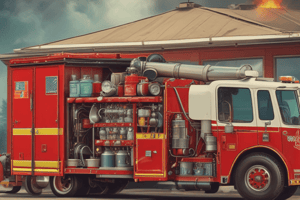Podcast
Questions and Answers
Flashcards are hidden until you start studying
Study Notes
Skidding and Braking Techniques
- To regain control during skidding, avoid using the brakes, and steer continuously.
- Major braking should occur before entering a turn for optimal control.
- Use engine and auxiliary brakes when driving downhill to manage speed effectively.
- Brake usage should be limited to short bursts of 5-10 seconds to maintain control.
Fire Apparatus Weight and Forces
- Centrifugal force causes objects to be pushed outward while rotating.
- One-third of the fire apparatus's weight is distributed on the front axle.
- A 7% differential in weight is permissible between the left and right sides of the apparatus.
Driving Precautions and Signals
- Critical speed refers to the maximum speed at which a fire apparatus can successfully navigate a turn.
- Turn off sirens 200 feet from intersections blocked by traffic; stop 100 feet from the nearest vehicle.
- Opticoms emit visible light and infrared signals to control traffic at intersections.
Staging and Incident Management
- Level 1 staging involves the initial crew responding while other units must stage one block away.
- NFPA 1561 governs the staging process and provides guidance for managing incidents.
- A Staging Area Manager (STAM) is identified by emergency lights while managing Level 2 staging.
Incident Scene Management
- Apparatus placement should prioritize rescue potential and exposure risks.
- The front of the building is designated for ladder trucks, not engines.
- At structure fires, engines with preconnect attack lines should park past the structure.
Equipment and Apparatus Specifications
- Building collapse zones are 1.5 times the building height; bowstring truss constructions require larger zones.
- Minimum compartment space requirements include 120 cubic feet for specialized apparatus.
- NFPA 1901 outlines standards for fire apparatus, including the minimum pump rating of 750 gpm.
Firefighter Safety and Health
- Firefighters must wear ANSI approved Class 2 reflective traffic vests for safety.
- Employers are responsible for ensuring that personnel do not participate if they have consumed alcohol within the last 8 hours.
- To stay hydrated, firefighters should consume 8-10 ounces of water every 5-10 minutes of exertion.
Incident Response Procedures
- Prioritize traffic control at vehicle accidents for the safety of victims and firefighters.
- Most vehicle fires (25% of all fires) are common, indicating a high frequency compared to structure fires.
Maintenance and Inspection Practices
- Loose pump seals may seem minor until they compromise the ability to draft and prime the pump.
- Scrape corrosion from battery terminals with a wire brush; do not loosen radiator caps on hot engines to avoid burns.
Training and Compliance
- NFPA 1451 mandates evaluating vehicle training effectiveness every three years.
- Follow proper guidelines (FCSP: fuel, choke, switch, pull) when starting power units.
Aerial Device Operational Standards
- Aerial devices must undergo annual testing, including full lift, extension, and 90-degree rotation tests.
- NFPA 1002 outlines requirements for safe operation and driving practices for firefighters responding to emergencies.
Advanced Technologies in Firefighting
- The S.M.A.R.T.E.R project utilizes technology to monitor stress, heart rate, body temperature, and respiratory rate in real-time during emergencies.
Studying That Suits You
Use AI to generate personalized quizzes and flashcards to suit your learning preferences.



